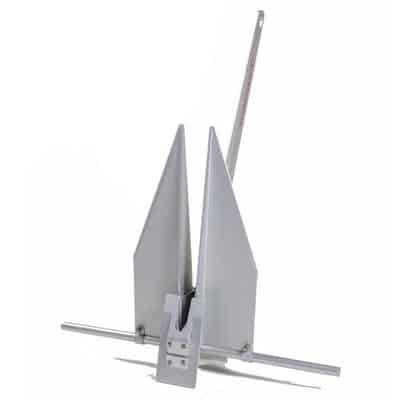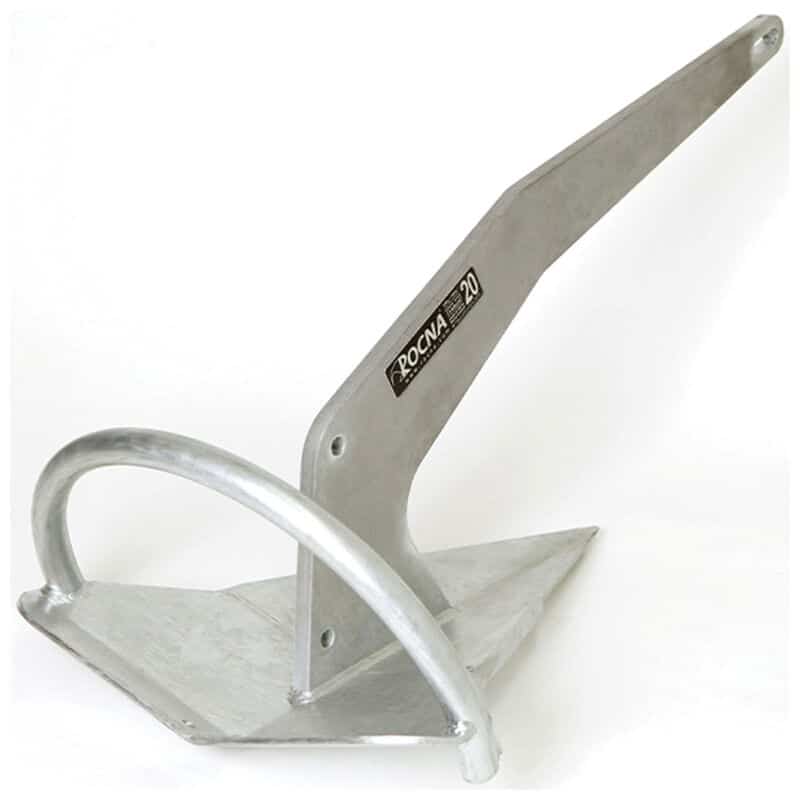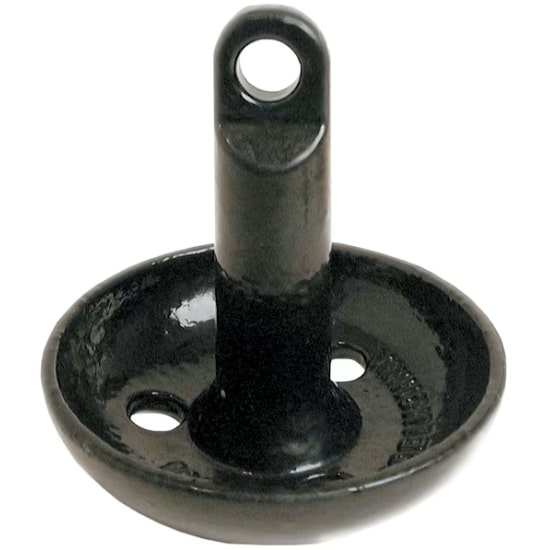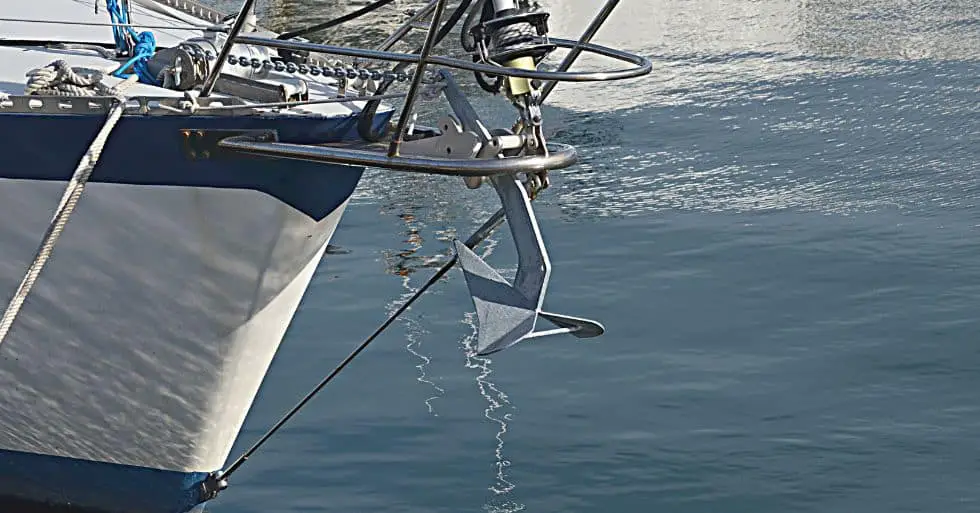Anchors are marine equipment widely used to prevent the movements of ships and boats in the water. In general, anchors use two main mechanisms to hold the ship; either they use their weight to hold the structure in place, or they clamp onto the bed of the water body. Some other anchors may use both mechanisms at the same time.
There are various kinds of anchors already used for ships and boats. In this article, we are going to learn about some of the most widespread anchors, in addition to some other useful information about anchoring.
How Does An Anchor Hold A Boat?
The very first force that prevents anchored ships from moving is the weight of the chain and anchor on the sea floor. Wind can push the boat away, but most anchors are designed to maintain their position and dig deeper into the ground as the wind pushes against the boat.
To lift an anchor, a boat should be just above before lifting it out. This way you can get it out of the sea floor easily without digging it even deeper.
Types of Anchors
Anchors have advanced dramatically over the previous decades. There is a variety of anchors available today for different scenarios. From more modern anchors including scoop anchors to more traditional ones like fisherman anchors, many options are ahead of you if you tend to buy an anchor for your boat.
You can choose the proper anchor for your boat according to the type of seabed in your area, the weight of your boat, and the material used in your anchor. Now, let us review some of the most common types of anchors.
Fluke Anchor

Related article: 7 Best Fluke Anchors (Ultimate Review)
Most popular in boats under 25 feet or as a stern anchor in larger boats
Also referred to as Danforth or Lightweight anchors, fluke anchors are the most common type of anchors. They come with wide and flat flukes made from strong steel. To keep your boat firmly in place, the flukes at the end of these anchors dig themselves into the seabed. The slight pulling force of the moving boat makes the anchor dig further into the seabed.
Most boat owners pick fluke anchors because they are lightweight and easy to handle, hence being appropriate for smaller boats. They also stow flat, leading to incredibly easy storage in small boats. Do not forget to store this anchor properly when you do not need it, as its sharp edges may harm you if kicked or stepped on accidentally.
They work best in seabeds such as sand and mud. They struggle in hard clay, gravel, and weeds and may need to be set manually in those seabeds.
Reference this chart to determine what size fluke anchor you should purchase:
| Boat Length (ft) | Steel Anchor Weight (lbs) | Aluminum Anchor Weight (lbs) |
|---|---|---|
| under 15′ | 4 lb | 4 lb |
| 16′-25′ | 8 lb | 4 lb |
| 26′-31′ | 16 lb | 7 lb |
| 32′-36′ | 22 lb | 10 lb |
| 37′-41′ | 33 lb | 15 lb |
| 42′-49′ | 44 lb | 21 lb |
| 50′-60′ | 55 lb | 32 lb |
| 60’+ | 60 lb+ | 47 lb+ |
Delta/Plow Anchor

Related Article: Plow/Scoop Anchor Review (Delta, Rocna, Vulcan, and CQR)
Most popular in boats 25-50 feet
Plow anchors are another extremely popular anchor used today. They are usually recognized by their resemblance to a large shovel or scoop. Plow anchors are able to hold boats better than fluke anchors in more seabeds. Including sand, mud, clay, gravel, and light weeds/grass.
Plow anchors are also used for large boats. They can easily adapt the situation of the boat to the direction of the wind. These anchors are more difficult to store than fluke anchors. Plow anchors can gradually “plow” themselves into the seabed, burying themselves there to hold the boat tightly in place.
Different plow anchors will have different recommendations for what size you should get, so make sure to always reference the manufacturers sizing guide. However, after combining a few of them, here is a good average for what size plow anchor you should get:
| Suggested Boat Length (ft) | Anchor Weight (lbs) |
|---|---|
| 9′-20′ | 10 |
| 21′-31′ | 15 |
| 25′-41′ | 22 |
| 35′-52′ | 35 |
| 40′-58′ | 45 |
| 45′-64′ | 55 |
| 65′-68′ | 70 |
| 60′-75′ | 90 |
| 76′-82′ | 110 |
| 80′-88′ | 140 |
Grapnel Anchor

Best used for very small boats such as kayaks or Jon boats
Either in fixed or folding forms, grapnel anchors do not have the ability to hinge or swivel. They use their weight and hooks to maintain the boats in their positions. These anchors are mostly used for smaller boats. The main disadvantage of grapnel anchors is that their upright flukes are prone to tangling with the anchor line, and pulling the anchor out can be challenging.
Grapnel anchors are sort of a jack-of-all-trades as they can hold in almost any seabed. This includes sand, mud, rocks, gravel, weeds, and more. Their holding power may not be as good as plow anchors, but they’re perfect for those who need to anchor in rocky seabeds.
Claw Anchor

Best for boats around 21-40 feet long
Since claw anchors are set easily and deal with most seabeds, they are among common boat anchors. They can cling to rocks easily, making them more ideal than previous anchors in this regard. Claw anchors are also known as Bruce anchors, as they have a wide three-claw design.
Despite clinging firmly to rocks and seabed structures, claw anchors are more difficult to set and hold. This forces you to choose a heavier claw anchor compared with previous anchor options. Also, claw anchors are hard to stow, similar to plow and grapnel anchors.
In the case of price, claw anchors are more affordable than other anchors. Thus, it is a more popular option among recreational boat owners.
For boats from 13 to 60 feet in length, you can purchase claw anchors from 6 to 66 pounds. It is obvious that you need heavier anchors for lengthier boats.
Scoop Anchor

Can be used for almost any boat
The term “scoop” actually refers to the new generation of modern anchor designs, including the Rocna, Spade, and Manson anchors. The popularity of these designs is soaring as they can work in many seabed types and have high holding power.
Scoop anchors can be set and reset more easily than other anchors. This helps you pick a lighter scoop anchor, as it can be set efficiently. Despite that, these anchors are more difficult to store on the deck.
Scoop anchors weighing from 10 to 65 pounds are used for boats from 13 to 60+ feet in length.
Rocna (the most popular scoop anchor brand) has a size chart for their anchors you can check out here. This will give you a good understanding of how big an anchor you will need.
Mushroom Anchor

Best for small boats under 21 feet
It is obvious from its name that a mushroom anchor is shaped like a mushroom. Mushroom anchors usually work in conditions where mud, silt, or sand shape the seabed. Other materials, including rocks, cannot grab mushroom anchors firmly.
Mushroom anchors need a counterweight to become buried in the seabed. It is used to make the shank lie down before it is buried. Mushroom anchors continue sinking into the seabed until they have moved the same mass as themselves. In other words, they can displace a huge amount of material and provide firm holding power.
To remove a mushroom anchor from the seabed, you need to dislodge the sand or mud surrounding it until the tension between the head and the seabed is weak enough for the motors on the structure to lift the anchor. This can be done by lifting it straight up with the rope or chain attached to it.
Fisherman Anchor

Best to be used as a decoration piece and not for an actual anchor
Fisherman anchors are able to firmly hold rock and weed, but their tiny flukes can drag on any other bottoms. Fishermen tend to drop their anchors where the fish are more likely to exist, like over reefs and rocky outcrops. It is not a big problem if their anchor drags, as they can simply re-anchor it.
Fisherman anchors are tough to handle. If you need them to provide strong holding power, you have to choose one that is extremely heavy. In addition to that, these anchors are considered dated, and very few people actually use them anymore.
They exist now for more as a decoration than to actually be used as there are many better options available.
How Deep Do Anchors Go?
Anchors are designed to dig into the seabed to prevent the boats from moving. They can hold the boat working together with their chains. Now, the question is, how much chain do you need?
A rule of thumb states that you generally need a chain as long as 5 to 7 times the depth of the water. Therefore, if the water is 20 feet deep, for example, you need at least 100 feet of chain.
The maximum depth that an anchor can go depends on the combination of the depth of the sea and the length of the chain.
How Many Anchors Do Boats/Ships Use?
Most of the time, it is enough to have only one anchor to keep a boat or ship in place. However, having only one anchor can make the ship move in a circle during tide and wind shifts. That is why sometimes ships need a second anchor off of the stern to maintain their position with minimum movement.
The other reason why some ships and boats have two anchors with them is that anchors can be lost easily due to heavy winds, bad weather, strong waves, etc. Also, different seabeds require different types of anchors, and this is another reason why it is recommended to have more than one anchor in the boat.
- What Is The Cheapest Way To Store A Boat? - February 28, 2023
- Do Boats Need Bottom Paint? (Uncovering the Truth) - February 2, 2023
- How Much Is Bass Boat Insurance? (Real Quotes) - January 18, 2023

